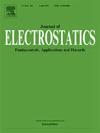太阳能电池阵列驱动组件中的磨料感应放电:实验与蒙特卡罗模拟
IF 2.1
4区 工程技术
Q3 ENGINEERING, ELECTRICAL & ELECTRONIC
引用次数: 0
摘要
磨料引起的电弧放电被认为是太阳能电池阵列驱动组件(SADA)失效的重要威胁。本研究试图找出SADA放电故障的原因,并提出保护策略。利用SADA电传输等效结构元件对磨料感应放电机理进行了实验研究,并利用粒子-细胞内蒙特卡罗碰撞(PIC-MCC)计算进行了相应的模拟。实验得到了失效结构的特征电压-电流曲线、电弧和辉光放电的时间演变。结果表明,在相同电压下,有磨料的放电特性曲线比无磨料的放电特性曲线更高、更陡。通过模拟得到了断口产生的等离子体分布、电场强度和电势分布,表明流动在远离电极尖端的地方形成,磨料引起的电场畸变对放电有显著影响。进一步对绝缘材料进行等离子体放电处理,观察到处理后绝缘材料的闪络电压升高。研究了结构元件的放电电压与放电次数的关系。结果表明,放电电压与放电次数之间无显著相关。然而,磨料的存在确实对放电电压有影响。从上面可以明显看出,SADA内部由磨损引发的放电引起的故障是不容忽视的。在表面闪络情况下,建议用等离子体处理绝缘材料以提高其闪络电压。本文为原创性研究,其研究结果对探索SADA摩擦放电导致内导电环失效的机理具有重要价值。本文章由计算机程序翻译,如有差异,请以英文原文为准。
Abrasive induced discharge in solar array drive assembly: Experiment and Monte Carlo simulation
Abrasive-induced arc discharge is considered a significant threat to the failure of Solar Array Drive Assembly (SADA). This study attempts to identify the causes of discharge faults in SADA and propose protective strategies. Experiments on the mechanism of abrasive-induced discharge using the equivalent structural components of the SADA electrical transmission and corresponding simulations using Particle-in-Cell Monte-Carlo-Collision (PIC-MCC) calculations are performed. The characteristic voltage-current curves, time evolution of arc and glow discharges of the failed structure were experimentally obtained. The results showed that the discharge characteristic curves with abrasives were higher and steeper than those without abrasives under the same voltages. Through simulations, the plasma distribution, electric field intensity, and potential distribution resulting from a break were obtained, revealing that the flow forms slightly away from the electrode tips, and the electric field distortion induced by abrasives has a significant impact on the discharge. Plasma discharge treatment was further conducted on the insulating material, and an increase in the flashover voltage of the treated insulating material was observed. The relationship between the discharge voltage of the structural component and the number of discharges was also investigated. The results indicated that there was not a significant correlation between the discharge voltage and the number of discharges. However, the presence of abrasives did have an impact on the discharge voltage. It is evident from the above that the failures induced by abrasion-triggered discharges inside the SADA cannot be overlooked. Treating the insulating material with plasma is recommended to increase its flashover voltage in surface flashover situations. This article represents original research, and its findings are of significant value in exploring the mechanism of abrasion-induced discharges leading to the failure of the internal conductive ring in SADA.
求助全文
通过发布文献求助,成功后即可免费获取论文全文。
去求助
来源期刊

Journal of Electrostatics
工程技术-工程:电子与电气
CiteScore
4.00
自引率
11.10%
发文量
81
审稿时长
49 days
期刊介绍:
The Journal of Electrostatics is the leading forum for publishing research findings that advance knowledge in the field of electrostatics. We invite submissions in the following areas:
Electrostatic charge separation processes.
Electrostatic manipulation of particles, droplets, and biological cells.
Electrostatically driven or controlled fluid flow.
Electrostatics in the gas phase.
 求助内容:
求助内容: 应助结果提醒方式:
应助结果提醒方式:


